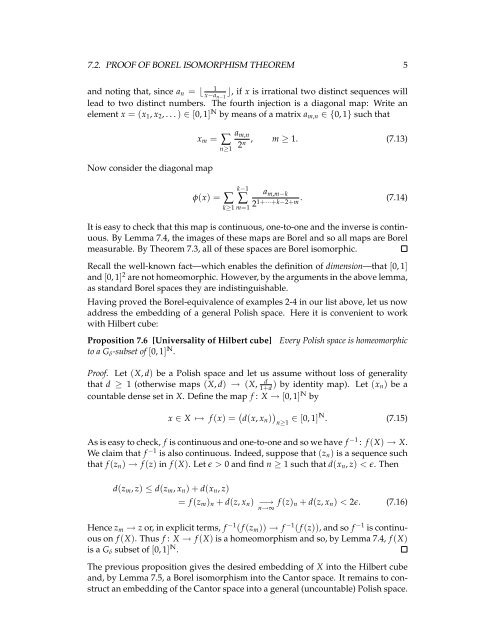You also want an ePaper? Increase the reach of your titles
YUMPU automatically turns print PDFs into web optimized ePapers that Google loves.
7.2. PROOF OF BOREL ISOMORPHISM THEOREM 5<br />
1<br />
and noting that, since an = b x c, if x is irrational two distinct sequences will<br />
an 1<br />
lead to two distinct numbers. The fourth injection is a diagonal map: Write an<br />
element x =(x1, x2,...) 2 [0, 1] N by means of a matrix am,n 2{0, 1} such that<br />
Now consider the diagonal map<br />
xm = Â n 1<br />
k 1<br />
f(x) =Â Â<br />
k 1 m=1<br />
am,n<br />
, m 1. (7.13)<br />
2n a m,m k<br />
. (7.14)<br />
21+···+k 2+m<br />
It is easy to check that this map is continuous, one-to-one and the inverse is continuous.<br />
By Lemma 7.4, the images of these maps are Borel and so all maps are Borel<br />
measurable. By Theorem 7.3, all of these <strong>spaces</strong> are Borel isomorphic.<br />
Recall the well-known fact—which enables the definition of dimension—that [0, 1]<br />
and [0, 1] 2 are not homeomorphic. However, by the arguments in the above lemma,<br />
as standard Borel <strong>spaces</strong> they are indistinguishable.<br />
Having proved the Borel-equivalence of examples 2-4 in our list above, let us now<br />
address the embedding of a general Polish space. Here it is convenient to work<br />
with Hilbert cube:<br />
Proposition 7.6 [Universality of Hilbert cube] Every Polish space is homeomorphic<br />
to a Gd-subset of [0, 1] N .<br />
Proof. Let (X, d) be a Polish space and let us assume without loss of generality<br />
that d 1 (otherwise maps (X, d) ! (X, d<br />
1+d ) by identity map). Let (xn) be a<br />
countable dense set in X. Define the map f : X ! [0, 1] N by<br />
x 2 X 7! f (x) = d(x, xn) n 1 2 [0, 1] N . (7.15)<br />
As is easy to check, f is continuous and one-to-one and so we have f 1 : f (X) ! X.<br />
We claim that f 1 is also continuous. Indeed, suppose that (zn) is a sequence such<br />
that f (zn) ! f (z) in f (X). Let e > 0 and find n 1 such that d(xn, z) < e. Then<br />
d(zm, z) apple d(zm, xn)+d(xn, z)<br />
= f (zm)n + d(z, xn) !<br />
n!• f (z)n + d(z, xn) < 2e. (7.16)<br />
Hence zm ! z or, in explicit terms, f 1 ( f (zm)) ! f 1 ( f (z)), and so f 1 is continuous<br />
on f (X). Thus f : X ! f (X) is a homeomorphism and so, by Lemma 7.4, f (X)<br />
is a Gd subset of [0, 1] N .<br />
The previous proposition gives the desired embedding of X into the Hilbert cube<br />
and, by Lemma 7.5, a Borel isomorphism into the Cantor space. It remains to construct<br />
an embedding of the Cantor space into a general (uncountable) Polish space.
















